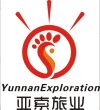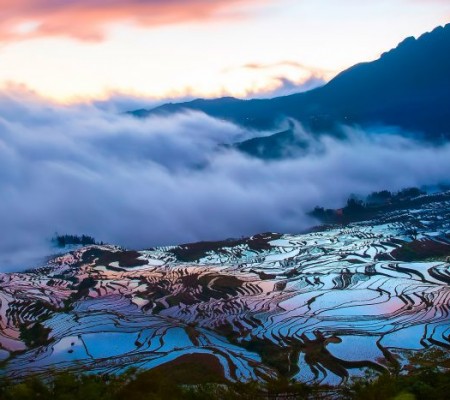
Lapu River of Jinsha-Yangtze River in Weixi County, Diqing
The (腊普河) Lapu River is located in (云南省迪庆藏族自治州维西傈僳族自治县塔城镇) Weixi Lisu Autonomous County, (迪庆藏族自治州) Diqing Tibetan Autonomous Prefecture, (塔城镇) Tacheng Town. It is a primary tributary of the (金沙江) Jinsha River. Its source, the (色马里底河) Shemali Di River, originates from the (云岭山脉) Yunling Mountain Range in the (梨地坪) Lidi Ping area. The river flows through (永春) Yongchun and (塔城) Tacheng towns before merging into the (金沙江) Jinsha River at (小河口) Xiaokou, with a total length of approximately 74 kilometers. The Lapu River valley is home to various ethnic minorities, including the Tibetan, Lisu, and Naxi people.
Cultural History
The name “Lapu” in Tibetan means “The River of the Sacred Stream” and is also known as the “Mother River” of (塔城镇) Tacheng Town. This area is not only a multi-ethnic settlement but also a region where diverse religious cultures intersect. There are one Christian church and three Tibetan Buddhist temples in the Lapu River valley. Additionally, Neolithic human cave dwelling sites have been discovered along the river, indicating that ancient ancestors lived near the water.
Folklore
The villages along the Lapu River preserve rich folk culture. For instance, the “热巴舞” (Reba Dance), a national intangible cultural heritage, is popular here. This ancient dance has a long history and a unique artistic style. The (腊普河) Lapu River valley’s (纳西族) Naxi, (傈僳族) Lisu, and other ethnic groups also maintain their traditional clothing and customs.
Weather and Best Travel Time
The (腊普河) Lapu River is located in the (云岭纵谷地区) Yunling Long Valley of the Hengduan Mountains, characterized by a subtropical and temperate monsoon plateau mountain climate, with notable topographical variations. The average annual temperature is about 13.1°C, and the annual precipitation is approximately 1000.7 mm. The best travel times are in the spring and autumn when the weather is pleasant, and the scenery is at its most beautiful.
Recommended Attractions
- (腊普河) Lapu River Villages: Experience the unique ethnic architectural style and folk culture.
- (达摩祖师洞) Damo Patriarch Cave: Located on a cliff near the Lapu River valley, this is an important Tibetan Buddhist site.
- (启别村千年银杏树) Qibie Village Thousand-Year-Old Ginkgo Tree: Situated downstream of the Lapu River, this ginkgo tree is over 3,000 years old and is regarded as a sacred tree by local villagers.
Suggested Stay Time for Each Destination
- Lapu River Villages: It is recommended to stay for 1 day to deeply experience local folk culture.
- (达摩祖师洞) Damo Patriarch Cave: It is recommended to stay for half a day to learn about the religious culture.
- (启别村千年银杏树) Qibie Village Thousand-Year-Old Ginkgo Tree: It is recommended to stay for half a day to appreciate the fusion of nature and culture.
Transportation
- By Car: Depart from (维西县城) Weixi County, head along the highway to (塔城镇) Tacheng Town, and then proceed to the villages along the Lapu River. The total distance is approximately 50 kilometers.
- By Public Transport: Take a bus from the (维西县) Weixi County bus station to (塔城镇) Tacheng Town, then switch to local transportation.
Local Cuisine
- (维西琵瑟肉) Weixi Pise Meat: A specialty of the Lisu ethnic group, with a unique flavor.
- (清汤鱼) Clear Soup Fish: Fresh fish from the (澜沧江) Lancang River, delicious in taste.
- (维西核桃) Weixi Walnuts: A local specialty, of excellent quality.
Shopping
- Ethnic Handicrafts: Such as wooden bowls and (糌粑盒) Tsampa boxes, rich in ethnic characteristics.
- (维西百花蜜) Weixi Honey: A local specialty with a rich and smooth taste.
Accommodation
There are Tibetan-style guesthouses available along the Lapu River in (塔城镇) Tacheng Town and surrounding areas, offering good conditions to experience Tibetan customs.
Travel Notes
- Respect Local Customs: When visiting, please respect the religious beliefs and traditional customs of the local ethnic groups.
- Protect the Environment: The Lapu River’s ecological environment is well-preserved, so please ensure you protect the environment during your visit.
- Safety: The roads leading to the Lapu River are quite rugged, so if traveling by car, be sure to take safety precautions.
Suggested Itinerary
- Day 1: Arrive at the villages along the Lapu River, visit traditional dwellings, experience local folk culture, and taste local cuisine.
- Day 2: Visit (达摩祖师洞) Damo Patriarch Cave and learn about religious culture; in the afternoon, visit (启别村千年银杏树) Qibie Village and its thousand-year-old ginkgo tree.
- Day 3: Return to (维西县城) Weixi County or continue to other attractions.
The (腊普河) Lapu River is a place full of natural beauty and cultural charm, ideal for tourists who enjoy folk culture and scenic landscapes. Here, you can experience the hospitality of the local people and appreciate the unique charm of ancient ethnic cultures. We hope your trip to the Lapu River is filled with wonderful experiences and unforgettable memories.

 7 Days GolfingTour
7 Days GolfingTour
 8 Days Group Tour
8 Days Group Tour
 8 Days Yunnan Tour
8 Days Yunnan Tour
 7 Days Shangri La Hiking
7 Days Shangri La Hiking
 11 Days Yunnan Tour
11 Days Yunnan Tour
 6 Days Yuanyang Terraces
6 Days Yuanyang Terraces
 11 Days Yunnan Tour
11 Days Yunnan Tour
 8 Days South Yunnan
8 Days South Yunnan
 7 Days Tea Tour
7 Days Tea Tour
 8 Days Muslim Tour
8 Days Muslim Tour
 12 Days Self-Driving
12 Days Self-Driving
 4 Days Haba Climbing
4 Days Haba Climbing
 Tiger Leaping Gorge
Tiger Leaping Gorge
 Stone Forest
Stone Forest
 Yunnan-Tibet
Yunnan-Tibet
 Hani Rice Terraces
Hani Rice Terraces
 Kunming
Kunming
 Lijiang
Lijiang
 Shangri-la
Shangri-la
 Dali
Dali
 XishuangBanna
XishuangBanna
 Honghe
Honghe
 Kunming
Kunming
 Lijiang
Lijiang
 Shangri-la
Shangri-la
 Yuanyang Rice Terraces
Yuanyang Rice Terraces
 Nujiang
Nujiang
 XishuangBanna
XishuangBanna
 Spring City Golf
Spring City Golf
 Snow Mountain Golf
Snow Mountain Golf
 Stone Mountain Golf
Stone Mountain Golf





